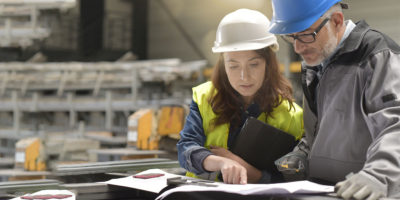Ergonomics – Chronic Back Injuries
Posted: Dec. 10, 2019 • By Kevin Kohler

My back hurts from time to time, but that seems normal around here
There is nothing “normal” about pain whether it occurs once and goes away or becomes chronic. Pain indicates a disorder in your body and is a signal for you to stop doing whatever is aggravating it, protect yourself from further injury, and heal.
Unfortunately back pain aggravated by work is all too common. Back pain resulting from injuries that are non-traumatic are a type of musculoskeletal disorder (MSD). According to Statistics Canada:
Back problems are among the most common chronic conditions in Canada. Four out of five adults will experience at least one episode of back pain at some time in their lives…
What’s a musculoskeletal disorder?
Ontario Workplace Safety and Prevention Services (WSPS) defines MSDs as:

“…injuries that affect muscles, tendons, ligaments and nerves. Injuries can develop when the same muscles are used repetitively, or for a long time without adequate rest. This type of injury increases if the force exerted is high and/or the job requires an awkward posture…. MSDs do not include musculoskeletal injuries or disorders that are the direct result of a traumatic event….”
The Centers for Disease Control and Prevention (CDC) defines work-related MSDs as conditions in which:
- The work environment and performance of work contribute significantly to the condition; and/or
- The condition is made worse or persists longer due to work conditions
Work related MSDs arise from the force we use and the way we move and position our bodies.
Is back pain that big a deal?
It’s a very big deal for employers, employees and society in general. According to Work Safe BC, back strain injuries are the most common injury type reported, accounting for 20% of disability claimants. WSPS says that MSDs account for 43% of all work-related injuries, 43% of all lost-time claim costs, and 46% of all lost-time days. A significant proportion of MSDs involve back injuries.
OSHA expects the effect of back injuries and disorders to increase over time as the work force gets older and medical costs increase. So it’s a big problem that’s getting bigger.
They tell me to practice proper ergonomics, what does that mean?

Ergonomics is the science of how people interact with their work environment. The goal of ergonomics is to ensure that workers interact in the safest and most efficient manner in order to reduce health and safety hazards.
Some factors that can act together over time when work is not well designed ergonomically, include:
- The amount of force that must be exerted
- The posture that must be adopted or held
- How often the work motions are repeated and at what frequency
Other factors such as vibration, temperature and pressure points can also contribute to poor ergonomics. Any awkward position, posture or movement can result in injury if repeated over time, including working at a desk or bench with very light items.
Hazard assessments and ergonomics
Assessing ergonomic hazards may require assistance from qualified specialists. Government safety organizations have designed assessment tools to help determine if a task is likely to create a hazard. Controlling the hazards may require work redesign and using industry best practices such as mechanical aids, properly designed standing surfaces, braces, and raised work object platforms. Training should be provided to workers on how to recognize ergonomic hazards and practice proper ergonomics. Your safety jurisdiction may mandate completing ergonomic hazard assessments or place limits on the force or weight that workers can lift or exert. As always you have a general duty to protect the health and safety of those working under you in all circumstances.
Related Articles

Safety Incentive Programs
We get a safety award every so often, I’m not sure why. Safety incentive programs are a traditional component of […]
Read Article
Discipline and Enforcement
It’s their own fault if workers get hurt not following the safety rules Actually, courts can and do find employers […]
Read Article